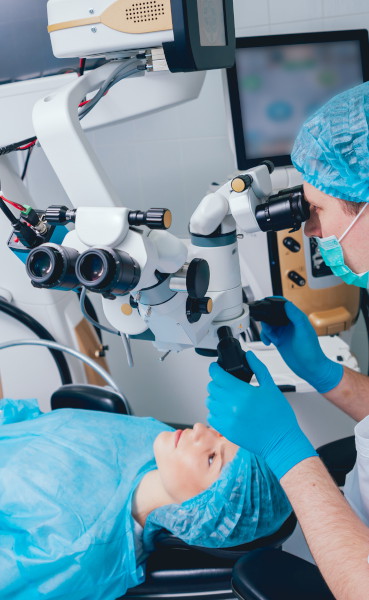What is presbyopia?
Presbyopia is a progressive loss of near vision due to aging. As we age, the lens of the eye becomes unable to focus light properly on the retina. This is known as a refractive error.
In presbyopia, the lens loses its flexibility and soft texture and becomes hardened. When this happens, it loses the ability to focus on objects up close — like a book or computer screen.
Presbyopia is a very common age-related condition, affecting 128 million Americans between the ages of 40 and 65.

What are the symptoms of presbyopia?
The symptoms of presbyopia include:
- difficulty seeing small print due to blurred vision
- holding reading materials farther away to maintain focus
- difficulty seeing things close up without assistance (readers, bifocals, etc.)
- eye strain
- headache
Can I get LASIK for reading vision correction?
Patients sometimes ask if LASIK (Laser-Assisted in Situ Keratomileusis) can eliminate reading glasses from their lives. Yes, it can!
If you’re tired of depending on readers, contact lenses, or eyeglasses, refractive surgery options are available for near-vision correction.
LASIK eye surgery was originally developed 30 years ago. Dr. Kerry Assil, of Assil Gaur Eye Institute (AGEI), was a pioneer in the early development of LASIK technology and continues to contribute to revolutionizing the LASIK field today.
Modern presbyopia laser eye surgery can correct reading vision problems using multiple techniques.
Monovision LASIK
Monovision LASIK for presbyopia is a vision correction procedure that helps to reduce or end the need for reading glasses. It works by correcting vision in each eye differently — the dominant eye is corrected for distance vision and the non-dominant eye is corrected for near vision — the same as monovision contact lenses.
According to the American Academy of Ophthalmology, some people find it difficult to adapt to the monovision experience. For this reason, ophthalmologists may recommend trying out monovision with contact lenses first before committing to the LASIK procedure.
Monovision corrects presbyopia for most people, but sometimes there are compromises:
- Some people find that correcting one eye for near vision makes their distance vision somewhat blurred, particularly in low-light conditions or when driving at night.
- For some people, monovision doesn’t provide enough magnification to see reading material with fine print.
Multifocal LASIK and PresbyLasik
Multifocal LASIK reshapes the surface of the eye to mimic the function of bifocal or multifocal contact lenses. This LASIK procedure can reduce the need for reading glasses, but there’s an increased risk of glare and halos after the procedure, which may be difficult to reverse.
Multifocal LASIK corrects presbyopia in the following way:
- An excimer laser reshapes the cornea into different zones for near, far, and intermediate vision. The brain determines the zone that provides the sharpest vision.
- In each zone, light bends differently, allowing people to regain quality vision at all distances — the same way multifocal contact lenses correct presbyopia.
However, multifocal contact lenses resting on the surface of the eye can move and cause visual distortions. Multifocal LASIK provides fixed, stationary zones directly on the eye’s surface.
Reading Vision LASIK
Reading Vision LASIK was invented by Dr. Kerry Assil in 2008. This procedure further customizes Multifocal LASIK by considering the variability of each patient’s pupil size.
In Reading Vision LASIK for presbyopia:
- The laser selectively sculpts only the segment of the cornea used for reading.
- The rest of the cornea isn’t modified, so vision at intermediate and farther distances remains unchanged.
- This reduces or eliminates the need for reading glasses.
Like the Monovision type, Reading Vision LASIK is usually performed on one eye. It has the advantage of creating separate focal zones for near and distance vision directly on the surface of your eye.
As a result, the eye that’s been corrected for near vision can see better at intermediate and farther distances than it would with Monovision LASIK.

PRK (LASEK)
When it was first introduced in 1995, PRK (or photorefractive keratectomy) was the first type of laser surgery for vision correction. This technology has evolved over the past two decades, and the newest generation PRK procedure is known as LASEK (for laser-assisted subepithelial keratectomy).
The key difference between LASEK and LASIK surgery has to do with where the laser sculpting takes place:
- With LASEK, the laser energy is applied directly to the surface of the cornea.
- With LASIK, the outer corneal layer is spared, and the laser energy is applied to the middle corneal layer.
LASEK is a simple, safe eye surgery that creates a sharper vision for people who are unsuitable candidates for LASIK but want vision correction surgery for their presbyopia.
Dr. Assil’s ground-breaking success performing delicate PRK eye surgery is known worldwide. Patients include professional athletes, other eye surgeons, and celebrities from around the globe.
It’s important to note that at AGEI, our eye surgeons use the same ultraviolet iFS Intralase excimer laser in both LASEK and LASIK procedures, so the final results are quite similar for both.
LASIK/LASEK procedures also treat hyperopia (farsightedness), myopia (nearsightedness), and astigmatism.
Am I a good candidate for LASIK surgery?
A good candidate will meet the following requirements:
- At least 18 years of age.
- Stable eyeglass and/or contact lens prescription for at least two to three years.
- Stable vision for at least the past year.
- No history or findings of active corneal disease.
- No significant medical or eye problems, such as previous corneal ulcers, keratoconus (a progressive thinning of the cornea, including an immediate family with this disease), diabetic retinopathy, macular degeneration, or glaucoma.
- No significant dry eye.
- Not pregnant or nursing.
If you are not a good candidate for LASIK, there are other surgical options for presbyopia treatment, including:
Corneal inlays
Corneal inlays — introduced over 20 years ago — are a type of laser eye surgery to correct reading vision. It involves placing an optical device underneath the corneal surface to improve near vision and reduce the need for reading glasses.
Refractive Lens Exchange (RLE)
Refractive lens exchange — the same method used for cataract surgery — can be used for presbyopia correction. RLE involves replacing the eye’s natural lens with an artificial intraocular lens implant (IOL). An IOL is approved by the FDA as a medical device to treat cataracts but is used off-label to correct presbyopia.
What if I’m not a good surgical candidate?
If you’re not a good candidate for presbyopia laser eye surgery and are tired of readers, glasses, and contact lenses, there is another treatment option. You can now benefit from a prescription eye drop. VUITY eye drops were FDA approved in October 2021.
The eye drops constrict the size of the pupil and increase the depth of focus in the eyes. The constricted pupil size improves the user’s reading vision.
As you age, it is important to monitor your eye health with an annual eye exam and to discuss any vision changes with your eye doctor (ophthalmologist or optometrist).
Assil Gaur Eye Institute of Los Angeles: Leaders in LASIK technology
Los Angeles’s leading LASIK, cataract, and retinal surgeons are available to you, all in one practice. State-of-the-art treatments for all eye conditions, including glaucoma, macular disease, dry eye, and diabetic eye conditions, to name just a few.
Assil Gaur Eye Institute remains laser-focused on our founding mission of providing exceptional health care in a compassionate and caring environment. We continue to be driven to advance the field of ophthalmology and give back to our community every day.
Please call (866) 945-2745 or make an appointment online.
We are conveniently located for patients throughout Southern California and the Los Angeles area at locations in or near Beverly Hills, Santa Monica, West Los Angeles, West Hollywood, Culver City, Hollywood, Venice, Marina del Rey, Malibu, Manhattan Beach, and Downtown Los Angeles.













